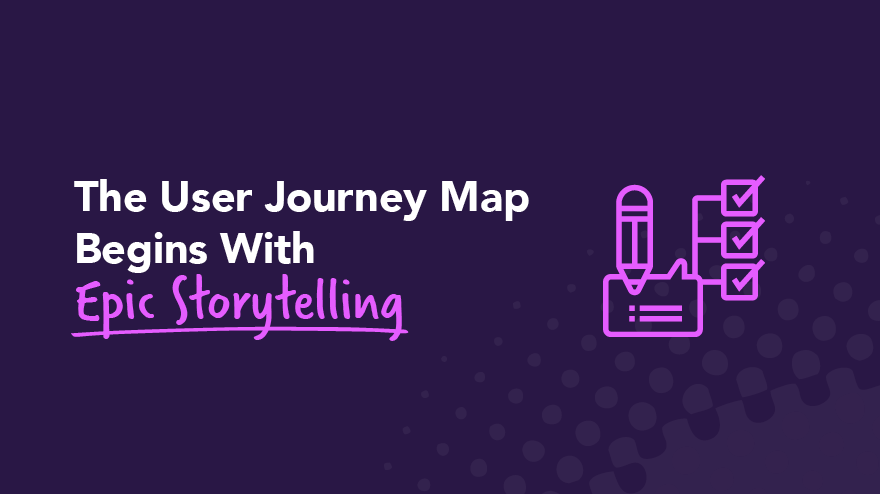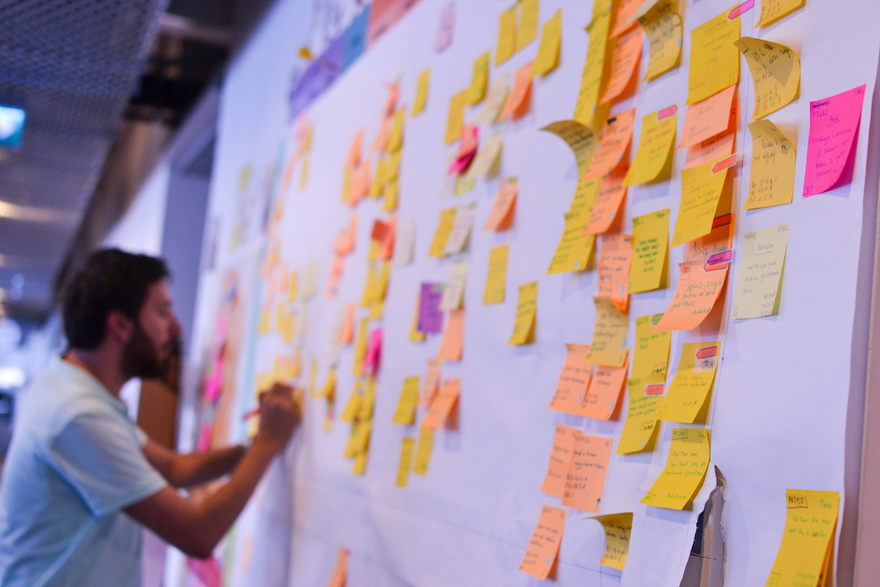Agile workflow
10 min read
The User Journey Map Begins With Epic Storytelling
Tue Jun 08 2021
Storytelling is an excellent way to describe anything because stories conjure detailed images. Once you create a visual association, cognitive processes leap into action to make the story in the user journey map a reality that is easy to track.
This is what the customer journey map (CJM) is all about—epic storytelling that involves comprehensive planning to capture the design process and deliver a unique customer experience.
Creating a customer journey map (also called the user journey map) involves planning a project from the user’s point of view and using personas, epics, features, user stories, and tasks. This visualization process also involves several stakeholders as user personas on the road to planning perfection.
By the end of the project, your CJM should help achieve business goals and exceed customer expectations with enough touchpoints along the way to motivate satisfaction. The process is a little like rubbing Aladdin's lamp to manifest your deepest wishes.
What is the user journey map?
In contrast to the flat backlog, the customer journey map makes the vision for your project come alive in real-time. You get to use creative storytelling to generate a magical customer experience through visual representations.
Project team members accomplish this by developing an empathy map to an almost-perfect plan from the customer’s perspective. User journey mapping captures the customer’s emotional state, which helps identify touchpoints and pain points. Teams then use these points to elevate the customer experience.
Unlike rubbing a genie’s lamp for results, you get to use convenient software to develop a service blueprint where design thinking reflects a shared vision between stakeholders.
The starting point is to anticipate customer interactions with the mobile app or other e-commerce project development story. That’s why user research is another vital element in developing the customer journey map template.
This customer journey map template should also draw valuable information from the empathy map and the experience map. An in-depth understanding of the KPIs and metrics that go into storytelling helps direct product usability through appreciating customer interactions with the product.
Customer interactions generate feedback, which leads to understanding customer's needs. Additional touchpoints can then be included or modified to build on the overall project outcomes.
Essentially, you use hierarchical storytelling on a magical customer journey map template to meet real-life expectations that resonate with the customer experience.
The customer journey mapping hierarchy

When beginning the journey to create the ideal customer experience, team members should visualize the project from the user’s current state. Once you capture the essence of the current customer perspective, you can better understand what needs to change and improve.
A simple example may be a travel app that encompasses services such as travel agent services, flight bookings, and accommodation in a geographical area (present state). The client wants to create a future state app which contains tourist activities to augment the customer experience. The basic process will then look like this:
For app customers who want a value-add experience with our travel app which is a helpful resource that provides tips on local tourist activities.
Your user journey map hierarchy involves four building blocks to meet customers’ needs:
- Understanding user personas or buyer personas
- Developing themes and epics to address touchpoints
- Using steps or features to support epics and the narrative flow
- The stories in the customer journey map
1. Understand user personas or buyer personas
The user journey map starts with defining the user personas or buyer personas as vital stakeholders in project development. These customer personas represent the top of the hierarchy, which is the starting point of the customer journey map.
A detailed visual reflection of the user persona is vital to getting your final product right. To deliver this, you need to walk through the story mapping journey from the customer’s perspective. This helps avoid the nasty consequences of inadequate planning that results in sub-optimum deliverables and unhappy teams and customers.
To understand user personas, you need to identify the various potential touchpoints in the journey and customer pain points through use cases and feedback. You’ll need to anticipate as many potential scenarios as possible from the buyer persona’s perspective.
Although the “who,” “what,” and “why” are instrumental in defining the user story, it all begins with visualizing user personas and thinking about customer behaviors, demographics, needs, and goals.
Once you define who your customer personas are, you can follow up with themes and epics to deliver on customer expectations. The epics are the heroes or heroines in this story visualization method.
2. Develop themes and epics to address touchpoints

The customer journey map positions epics at the top of the storyboard because they are vital to creating a great project.
Team leaders must consult with the client and relevant stakeholders to develop an overarching project theme, to translate into epics. Epics flow through this theme from left to right. These epics show large bodies of work broken down into smaller features which can meet continuous delivery value.
Epics are also strategic directives that begin with the current state of an issue and move the situation into a desirable future state. This epic future state is built on tactics, or features and tasks, which team members use to clarify project requirements and move toward that magical future state of project success.
Before team members can move forward, they need to get the epics right. Epics cover three fundamental foundations: user persona, product, and design requirements, which reflect visually on the user journey map.
The epics should meet several foundational requirements:
- Follow through by aligning the overall business goals with detailed buyer personas and demographics
- Broadly outline the user persona’s needs
- Meet specific customer needs by addressing touchpoints and pain points
- Include specific functions, features, and benefits
- Produce a future state ideal project
After designing your heroic epics to cover the project's primary goals, you can start breaking these into steps that integrate with the overall narrative flow of the user story.
3. Use epics for highlighting the narrative flow
Once you clearly define your epics, it’s time to generate narrower steps or features.
As your epics move from left to right, you must define each of the necessary steps to accomplish business goals. This customizable process uses epics to relay the user journey over the project duration to reflect project outcomes.
The customer journey map template also forms the basis of the ideal user story as you transition from epics to features. The features originate from the epics, which is why the epics are the heroes in this story. They “save” customers with excellent planning and deliverables.
At its most basic level, features should include the following elements:
- Deliverables that add value and support epics completion
- Generate business value by considering KPIs, metrics, customer acquisition, and retention
- Demonstrate sufficient definition for team members to follow through on time estimates and complete tasks within one to three sprints
- Team members must be able to test the results of their features
- Establish test criteria for each feature to set acceptable quality standards that meet customer expectations before moving to the next step
In short, the user acceptance criteria (UAC) in the user journey map should include a brief item value description, a feature benefit explanation, and the feature quality completion points that team members must achieve.
Only once you nail these details can you tell the user stories from the customer's perspective. Similarly, only once you complete these three fundamental building blocks in the customer journey map can you focus on user stories and business goals that include customer satisfaction and retention.
4. Begin storytelling through the user journey map
After the third step in the hierarchy of the user journey map, the actual user stories begin. This is the final step in design thinking related to the visualization of epics into manageable stories and tasks.
To state the buyer persona case, team members must understand the “who,” “what,” and “why” of the customer experience. Understanding and defining the customer personas forms the basis of user story creation, enabling delivery of the most acceptable product possible.
Developing the best story relies on creating user stories that highlight the customer experience and use cases that highlight the finer details of system performance.
In the story creation phase, team members assume the customer’s perspective to define requests. Team members can consider exploring social media to understand customer behavior and experiences to use as story inputs. User stories can also include enabler tasks to augment feature completion.
Team members typically write their user stories to complete these in short sprints. Sprint completion involves task completion for release before completing one epic and moving to the next, except where concurrent work is possible.
Ultimately, the user journey map must tell the customer’s story of how their need will be met by creating or modifying a product, process, service, or system feature. New developments must follow through on the formula of “as a…” “I want…” “so that...”
As a new Agile team member, I want to understand my and other team member's roles so that I am clear about my tasks and the responsibilities of other team members.
After generating user stories, team members can break tasks into even smaller parts to facilitate work deliverables and reduce potential churn that negatively impacts customer retention.
As the user journey map progresses, the stories should clearly outline the activities for completion, always linking these back to buyer persona goals. The smaller, granular tasks then relate to user behaviors, and the outcomes link to each step of the process to reinforce what deliverables will meet customer needs within set timeframes.
During the customer journey map, stories can be split further to accomplish greater clarity.
Bottom line: The customer journey map
Through the customer journey mapping process, you should capture the primary epics of the user journey in the story map visualization.
You will need to develop the user story map holistically and interrupt it with additions and subtractions in an iterative fashion. This iterative user story mapping process helps minimize churn as you continue to update your story as you move forward.
Once the project is done, you need to test the product on potential customers, gather customer feedback, and improve the user journey map.
The benefits of carefully planning the customer experience through a visual format are exponential.
Tell your project story with Easy Agile User Story Maps for Jira
The customer journey should highlight the ideal user experience. To do this, the user story map should incorporate the project from user personas to achieve stories with valuable touchpoints as markers along the way.
Once the visual representation is done, it should validate the service blueprint for the customer journey mapping process through the current and future states of the project.
Throughout the project, your team should create a unique user journey that delivers the ultimate customer experience and exceeds customer expectations.
Try Easy Agile TeamRhythm and Personas today to make your customers' stories come alive with magic.


